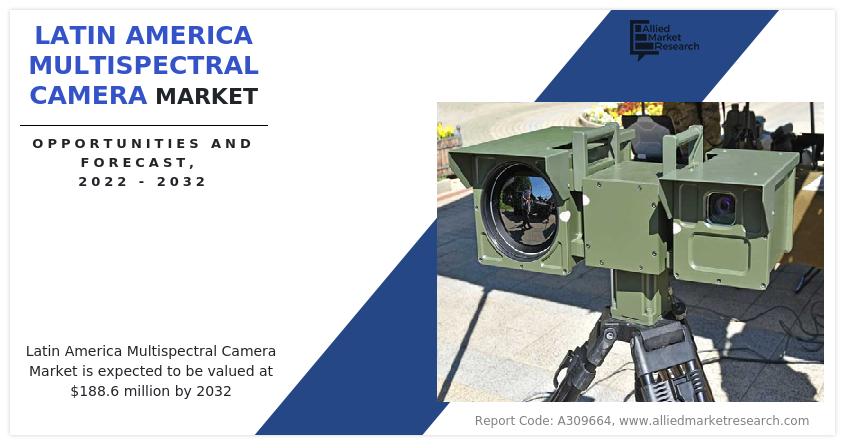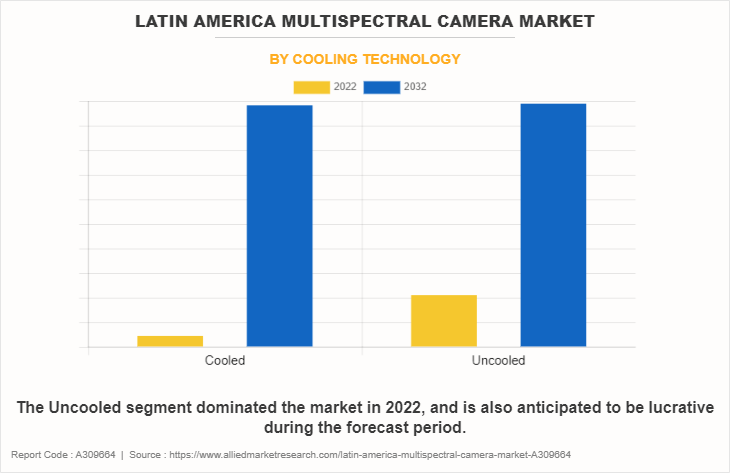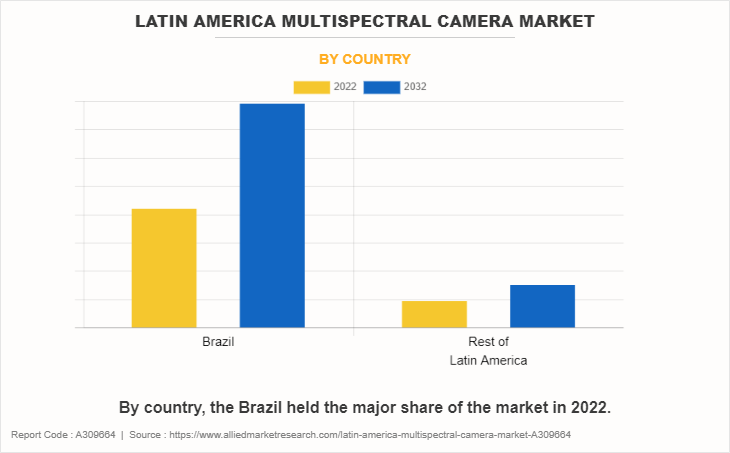An imaging equipment that can record data outside the visible light spectrum is called a multispectral camera. This implies that it can see things, such as infrared and ultraviolet wavelengths, that are just not visible to human eyes. This enables the camera to be used across various applications in the defense sector such as intelligence, surveillance, and reconnaissance; target and tracking; navigation and guidance; and others.
Multispectral cameras are gaining popularity for use in defensive applications. There are various elements that influence this, such as:
- Growing Security Concerns: Drug trafficking, illicit mining, and border security concerns are just a few of the security issues that Latin American nations must deal with. In these situations, multispectral cameras provide useful instruments for monitoring and obtaining intelligence.
- Enhanced Protection at the Border: Conventional monitoring techniques face difficulties since Latin American countries have large and frequently remote borders. Multispectral cameras are useful for spotting unlawful activity and incursions since they can see through greenery and dim lighting.
- Crime prevention and counterterrorism: Multispectral cameras can be used to detect and follow possible threats, giving important information for these initiatives.
- Possibility of Domestic Production: A few Latin American nations are attempting to create their own defense technologies, such as multispectral cameras. These lead to future acceptance and cost-effectiveness

Nonetheless, laws limiting the placement of these cameras in airspace and their distribution throughout sensitive regions are among the barriers impeding the integration of multispectral cameras. Furthermore, these high-end cameras come at a premium price. These are a few of the issues limiting the multispectral camera market expansion throughout the area.

The COVID-19 pandemic has impacted the Latin America multispectral camera market, causing disruptions in the supply chain and production processes. Fluctuating demand and economic uncertainties have influenced market dynamics. Despite challenges, the market experienced a rapid recovery owing to the rise in investment by the defense sector in the procurement of aerial, land, and marine vehicles for their defense personnels.
The Latin America multispectral camera market is segmented into cooling technology, end use, imaging spectrum, application, and platform. On the basis of cooling technology, the market is bifurcated into cooled and uncooled. On the basis of end use the market is segmented into man-portable and payloads. On the basis of imaging spectrum, the market is categorized into visible/near-infrared (VNIR), short-wave infrared (SWIR), mid-wave infrared (MWIR), and long-wave infrared (LWIR). On the basis of application, the market is divided into intelligence, surveillance, and reconnaissance; target and tracking; navigation and guidance; and others. On the basis of platform, the market is segmented into land, air, and marine.

On the basis of country, the Latin America multispectral camera market is analyzed across Brazil and the rest of Latin America. Brazil is the largest market shareholder due to the country’s constantly increasing military expenditure to integrate advance technologies across all its defense platforms such as land, air, and marine.

Competitive analysis and profiles of the major Latin America multispectral camera market players that have been provided in the report include Teledyne Digital Imaging Inc.; Leonardo DRS; Raytheon Technologies Inc (Collins Aerospace); HENSOLDT AG; SILIOS Technologies; JAI A/S, Telops Inc; L3Harris Technologies, Inc; Kappa optronics GmbH; Surface Optics Corporation. The key strategies adopted by the major players of the Latin America multispectral camera market include product launch and mergers & acquisitions.
Multispectral cameras are among the defense technology that several Latin American nations are hoping to develop on their own. This results in future acceptance and cost-effectiveness.
The Latin America multispectral camera market is highly competitive, owing to the strong presence of existing vendors. Vendors of the Latin America multispectral camera market with extensive technical and financial resources are expected to gain a competitive advantage over their competitors because they can cater to market demands. The competitive environment in this market is expected to worsen as technological innovations, product extensions, and different strategies adopted by key vendors increase.
Key Developments & Strategies
- In October 2023, A partnership led by Brazilian technology company Atech was given a $5 million contract by the Brazilian Institute of Environment and Renewable Natural Resources (IBAMA) for 20 multispectral cameras fitted with drones.
- In June 2023, Elbit sensors, an Israeli defense company, and the Colombian Air Force inked a $12 million deal for 12 Hermes 900 MALE (medium-altitude long-endurance) drones fitted with multispectral imaging sensors.
KEY BENEFITS FOR STAKEHOLDERS
- This study comprises analytical depiction of the Latin America multispectral camera market size along with the current trends and future estimations to depict the imminent investment pockets.
- The overall Latin America multispectral camera market analysis is determined to understand the profitable trends to gain a stronger foothold.
- The report presents information related to key drivers, restraints, and opportunities with a detailed impact analysis.
- The current Latin America multispectral camera market forecast is quantitatively analyzed from 2022 to 2032 to benchmark the financial competency.
- Porter’s five forces analysis illustrates the potency of the buyers and suppliers in the smart display.
- The report includes the market share of key vendors and Latin America multispectral camera market.
Latin America Multispectral Camera Market Report Highlights
| Aspects | Details |
| Market Size By 2032 | USD 188.6 million |
| Growth Rate | CAGR of 6.4% |
| Forecast period | 2022 - 2032 |
| Report Pages | 120 |
| By Cooling Technology |
|
| By End Use |
|
| By Imaging Spectrum |
|
| By Application |
|
| By Platform |
|
| By Country |
|
| Key Market Players | FLIR Systems, Thales Group, Leonardo, Teledyne Technologies, Aselsan A.S., Safran Group, RADA Electronic Industries, Raytheon Company, Israel Aerospace Industries, Harris Corporation |
The Latin America Multispectral Camera Market is estimated to reach $188.6 million by 2032
Leonardo, Thales Group, Teledyne Technologies, Harris Corporation, Raytheon Company, Israel Aerospace Industries, RADA Electronic Industries, Aselsan A.S., Safran Group, FLIR Systems are the leading players in Latin America Multispectral Camera Market
1. The report provides a comprehensive analysis of the current market estimations through 2022-2032, which would enable the stakeholders to capitalize on prevailing market opportunities. 2. Major countries are mapped according to their revenue contribution to the latin america multispectral camera market. 3. In-depth analysis of the latin america multispectral camera market segmentation assists to determine the prevailing market opportunities. 4. Identify key players and their strategic moves in latin america multispectral camera market. 5. Assess and rank the top factors that are expected to affect the growth of latin america multispectral camera market. 6. Analyze the market factors in various countries and understand business opportunities. 7. Player positioning provides a clear understanding of the present position of key market players.
Latin America Multispectral Camera Market is classified as by cooling technology, by end use, by imaging spectrum, by application, by platform
Loading Table Of Content...
Loading Research Methodology...



